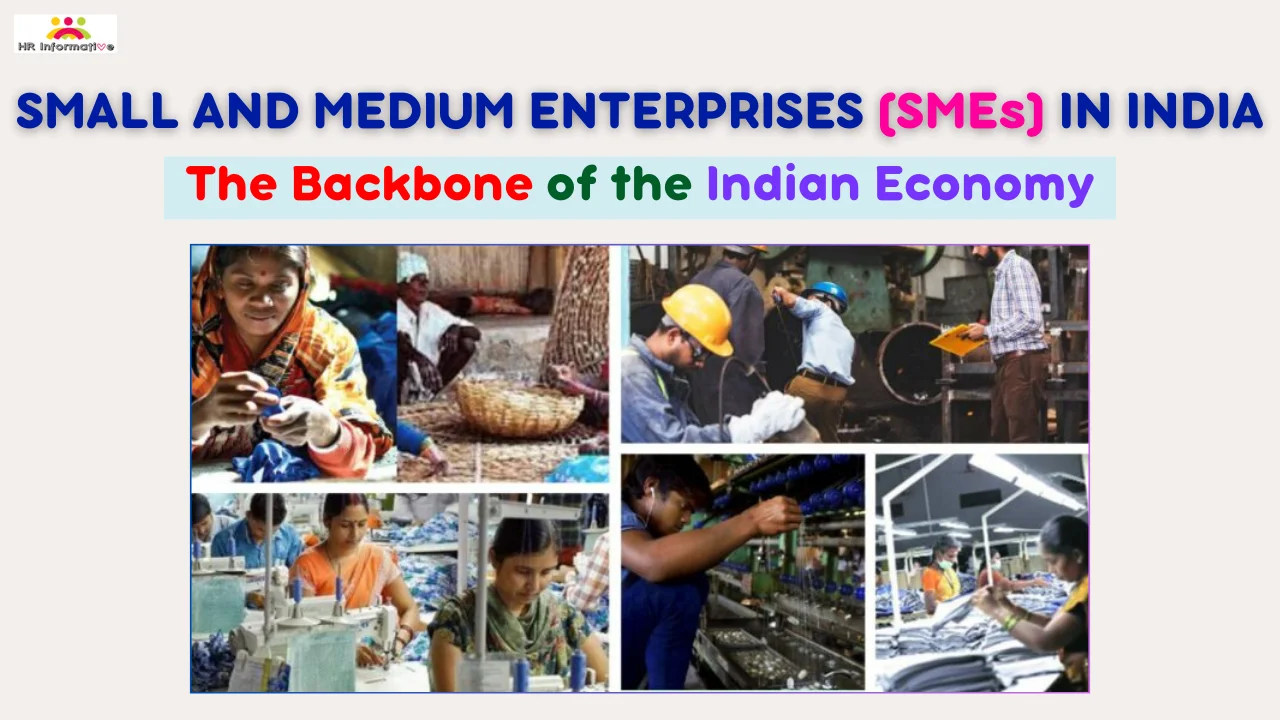Introduction
SMEs, or small and medium enterprises, are the backbone of the Indian economy. They play a vital role in employment generation, economic growth, and regional development. SMEs account for over 90% of industrial units in India and contribute to around 40% of value addition in the manufacturing sector. They also employ over 111 million people, which is around 40% of the total workforce in the country.
Definition of SMEs
The Micro, Small and Medium Enterprises Development Act, 2006 defines SMEs as follows:
- Micro Enterprise: An enterprise with an investment in plant and machinery or equipment not exceeding Rs. 1 crore.
- Small Enterprise: An enterprise with an investment in plant and machinery or equipment not exceeding Rs. 10 crore.
- Medium Enterprise: An enterprise with an investment in plant and machinery or equipment not exceeding Rs. 50 crore.
Importance of SMEs
SMEs play a significant role in the Indian economy for the following reasons:
- Employment Generation: SMEs are a major source of employment in India, especially in the rural and semi-urban areas. They employ over 111 million people, which is around 40% of the total workforce in the country.
- Economic Growth: SMEs contribute to around 40% of value addition in the manufacturing sector and around 35% of India’s GDP.
- Regional Development: SMEs are spread across the country and contribute to the development of rural and semi-urban areas.
- Exports: SMEs account for over 45% of India’s exports.
- Innovation and Entrepreneurship: SMEs are a breeding ground for innovation and entrepreneurship. They are constantly developing new products and services and expanding into new markets.
Read Also : Stakeholders: A Detailed Overview
Challenges Faced by SMEs
SMEs face a number of challenges, including:
- Access to Finance: SMEs often find it difficult to access finance from formal financial institutions. This is due to a number of factors, such as lack of collateral, limited financial track record, and complex documentation requirements.
- Marketing and Technology: SMEs often lack the resources to market their products and services effectively. They also find it difficult to adopt new technologies due to the high cost involved.
- Government Regulations: SMEs often find it difficult to comply with complex government regulations.
Government Support to SMEs
The Indian government has taken a number of steps to support SMEs, including:
- Establishing the Ministry of Micro, Small and Medium Enterprises (MSME): The MSME is responsible for formulating and implementing policies and programs for the development of SMEs.
- Providing Financial Assistance: The government provides a number of financial assistance schemes to SMEs, such as the Credit Guarantee Scheme for Micro and Small Enterprises (CGTMSE) and the Mudra Yojana.
- Launching Skill Development Programs: The government has launched a number of skill development programs to improve the skills of SME workers.
- Simplification of Government Regulations: The government has taken a number of steps to simplify government regulations for SMEs, such as the introduction of the single-window clearance system.
Key Sectors Where SMEs Operate in India
The key sectors where SMEs operate in India include:
Manufacturing: SMEs play a vital role in the Indian manufacturing sector, accounting for over 90% of all manufacturing units and contributing to around 40% of value addition in the sector. Some of the key manufacturing sectors where SMEs operate include:
- Engineering and Machinery
- Food Processing
- Textiles and Apparel
- Chemicals and Pharmaceuticals
- Electronics and Electrical
- Automobiles and Auto Components
Agriculture: SMEs play a major role in the Indian agricultural sector, providing employment to over 60% of the workforce and contributing to around 18% of GDP. Some of the key agricultural sectors where SMEs operate include:
- Dairy
- Fisheries
- Horticulture
- Livestock
- Poultry
Services: SMEs are also major contributors to the Indian services sector, accounting for over 60% of employment in the sector. Some of the key services sectors where SMEs operate include:
- IT and Business Process Outsourcing (BPO)
- Retail and Trade
- Hospitality and Tourism
- Education and Healthcare
- Transportation and Logistics
In addition to the above sectors, SMEs also operate in a number of other sectors, such as construction, media and entertainment, and renewable energy.
Read Also : Understanding the Concept of Principal Employer in India
Government Schemes and Programs that Support SMEs in India
The Indian government has introduced a number of schemes and programs to support SMEs, including:
- Credit Guarantee Scheme for Micro and Small Enterprises (CGTMSE): This scheme provides credit guarantees to banks and other financial institutions for lending to MSMEs. This helps to improve the access of MSMEs to finance.
- Mudra Yojana: This scheme provides loans to micro-enterprises, which are businesses with an investment in plant and machinery or equipment not exceeding Rs. 10 lakh. The loans are provided through banks, microfinance institutions, and non-banking financial companies (NBFCs).
- Prime Minister’s Employment Generation Programme (PMEGP): This scheme provides financial assistance to micro-enterprises for setting up new businesses or expanding existing businesses. The assistance is provided through banks and other financial institutions.
- National Manufacturing Competitiveness Programme (NMCP): This program aims to improve the competitiveness of the Indian manufacturing sector by providing financial assistance to MSMEs for technology upgradation, skill development, and market development.
- Skill India Mission: This mission aims to train and upskill millions of Indians, including SME workers. The mission provides financial assistance and other support to training providers.
- Make in India: This initiative aims to promote manufacturing in India and make the country a global manufacturing hub. The initiative provides a number of benefits to MSMEs, such as tax breaks and access to credit.
- Startup India: This initiative aims to promote startups in India and create a supportive ecosystem for them to grow and thrive. The initiative provides a number of benefits to startups, such as tax breaks and access to funding.
Future of SMEs in India
The future of SMEs in India is bright. The Indian government is committed to supporting the growth and development of SMEs. With the government’s support and the increasing entrepreneurial spirit in the country, SMEs are poised to play an even more important role in the Indian economy in the years to come.
Conclusion
SMEs play a vital role in the Indian economy. They are a major source of employment, economic growth, and regional development. The Indian government has taken a number of steps to support SMEs, such as establishing the Ministry of MSME, providing financial assistance, launching skill development programs, and simplifying government regulations. The future of SMEs in India is bright, and they are poised to play an even more important role in the Indian economy in the years to come.
FAQs
Q: What is an SME?
Ans: An SME, or small and medium enterprise, is a business that meets certain criteria in terms of size and revenue. In India, SMEs are defined as businesses with an investment in plant and machinery or equipment not exceeding Rs. 50 crore.
Q: Why are SMEs important for the Indian economy?
Ans: SMEs are crucial for various reasons, including being a significant source of employment, contributing to economic growth (40% value addition in manufacturing), aiding regional development, accounting for a substantial portion of India’s GDP, and fostering innovation and entrepreneurship.
Q: What challenges do SMEs face in India?
Ans: SMEs encounter challenges such as limited access to finance, difficulties in marketing and technology adoption, and struggles with complex government regulations.
Q: How is the Indian government supporting SMEs?
Ans: The government supports SMEs through initiatives like the Ministry of Micro, Small and Medium Enterprises (MSME), financial assistance schemes (e.g., CGTMSE, Mudra Yojana), skill development programs, and simplification of government regulations, fostering a conducive environment for SME growth.
Q: In which key sectors do SMEs operate in India?
Ans: SMEs are prevalent in sectors such as manufacturing (engineering, food processing, textiles, etc.), agriculture (dairy, fisheries, horticulture, etc.), and services (IT, BPO, retail, hospitality, etc.). They also operate in construction, media, entertainment, and renewable energy.
Q: What are some government schemes supporting SMEs in India?
Ans: Notable schemes include CGTMSE for credit guarantee, Mudra Yojana for micro-enterprises, PMEGP for employment generation, NMCP for manufacturing competitiveness, Skill India Mission for skill development, Make in India for promoting manufacturing, and Startup India for supporting startups.
Q: How can SMEs benefit from government support programs like Startup India and Make in India?
Ans: SMEs can benefit from tax breaks, access to funding, and a supportive ecosystem provided by initiatives like Startup India and Make in India, fostering their growth and competitiveness.
You May Read Also :
- Understanding Exempted and Unexempted Establishments in EPF
- Gratuity in India: Eligibility, Calculation, Forfeiture and Related Forms
- Scheduled Employment under the Minimum Wages Act, 1948: Ensuring Fair Compensation and Dignity for Workers
- Exploring the ESI Scheme: Eligibility, Coverage, Benefits, and Employer Liability



